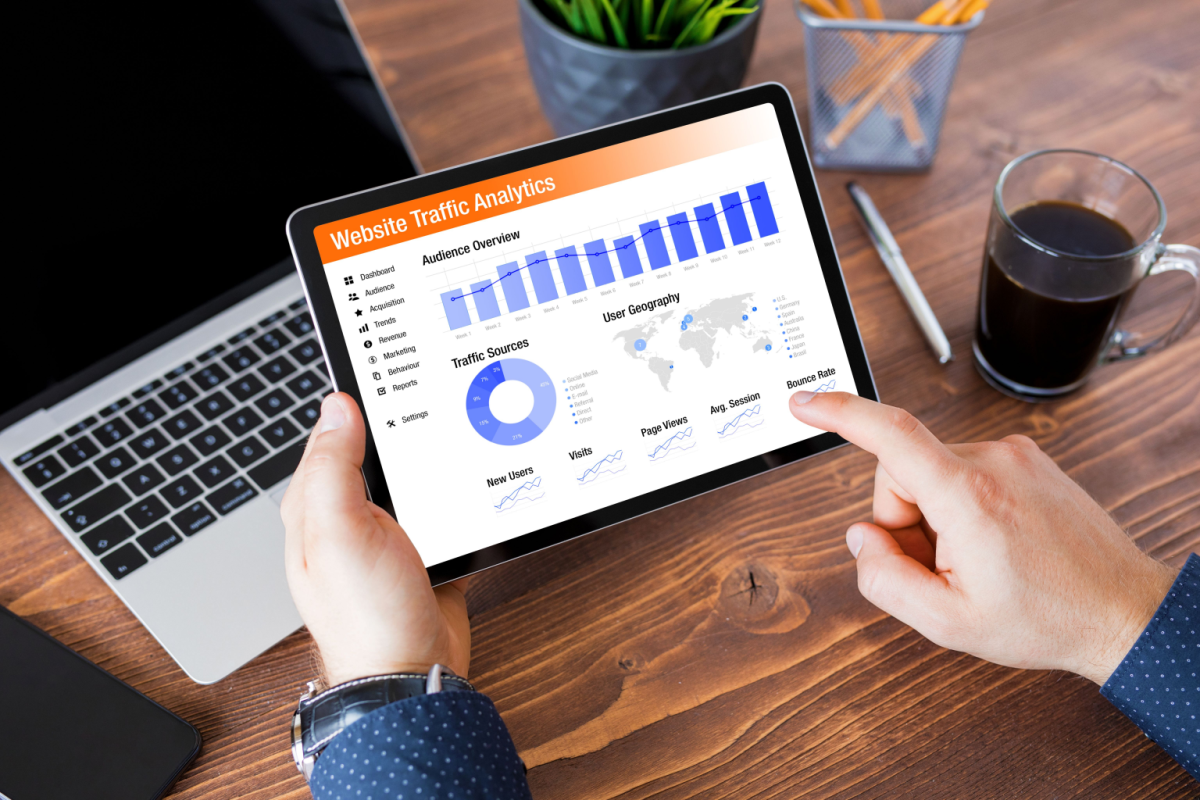Knowing which key performance indicators (KPIs) to track can help you measure the effectiveness of your marketing campaigns, analyze your progress, and make necessary adjustments to ensure maximum return on investment (ROI). But which B2B marketing KPIs should you focus on?
This article will discuss the top business-to-business (B2B) marketing KPIs you need to track to ensure your marketing efforts are successful and effective. From website and social media analytics to lead conversion rates and customer lifetime value, these KPIs will help you measure your progress and achieve your business goals. So, let’s dive in!
What is a B2B Marketing KPI?
A B2B marketing KPI is a metric used to measure the success of a company’s marketing efforts. These KPIs help companies identify improvement areas. KPIs also provide insight into how a business’s marketing strategies are performing.

B2B marketing KPIs can include metrics such as website traffic, lead generation, lead conversion rate, cost per lead, return on investment, and customer lifetime value. Companies use these KPIs to determine how effective their marketing efforts are and to make informed decisions about future marketing campaigns.
Why is it Important?
B2B marketing KPIs may provide insight into how effectively a campaign reaches its goals and objectives, such as increasing brand awareness, generating leads, and driving sales.
Additionally, digital marketing KPIs can help marketers identify areas of opportunity, allowing them to focus their efforts on the most effective channels and tactics. Ultimately, these KPIs provide valuable information that can be used to make informed decisions about optimizing future campaigns and maximizing ROI.
Why You Can’t Measure B2B Marketing with B2C Metrics
When it comes to marketing metrics that matter, remember that B2B and business-to-consumer (B2C) marketing strategies differ quite a bit. B2B marketing focuses on building relationships with other businesses, while B2C marketing focuses on selling products or services directly to consumers.
Therefore, it is not possible to measure the success of B2B marketing using B2C metrics. For instance, B2B marketing KPIs measure customer lifetime value, customer acquisition cost, and customer retention rate, which are all tailored to the needs of businesses. Additionally, B2B marketing requires a longer sales cycle and often involves multiple decision-makers, so the metrics used must be able to capture the complexity of the process.
Cost Per Lead (CPL)
Cost per lead (CPL) is a commonly tracked KPI in B2B marketing management because it helps determine a business’s ROI. CPL measures how much it costs to acquire a new lead or customer.
CPL is calculated by dividing the total cost of a marketing campaign by the number of leads generated.
For example, if you’ve spent $1,000 on a campaign and received 10 leads, your CPL would be $100.
To calculate CPL, you need to measure your marketing costs accurately. This includes all expenses associated with the campaign, such as ad spend, content creation, and staff time.
Once you’ve calculated your total marketing costs, you can then divide it by the total number of leads acquired. You can also use this information to compare your CPL with other campaigns or industry averages.
CPL should be used as a measure of success because it helps you determine how much you’re spending to acquire a new lead. If the CPL is lower than the revenue generated from a new lead, the campaign is considered to have a positive ROI. Conversely, if the CPL is higher than the revenue generated, the campaign is considered to have a negative ROI. CPL can also be used to compare the efficiency of different marketing channels or campaigns, with a lower CPL indicating a more cost-effective campaign.
Customer Lifetime Value
Customer lifetime value (CLV) is a B2B marketing KPI that measures the total amount of revenue generated by a single customer over the course of their relationship with a company. Calculating CLV helps businesses understand the long-term value of their customers and allocate resources to maximize customer retention and satisfaction. The CLV formula is the following:
CLV = (Average Purchase Value X Number of Purchases per Year X Average Customer Lifetime) – (Customer Acquisition Cost
For example:
Average Purchase Value: $100
Number of Purchases per Year: two
Average Customer Lifetime: five years
Customer Acquisition Cost: $200
CLV = ($100 X 2 X 5) – $200 = $800
This means that the estimated total revenue generated by this customer over the course of their lifetime is $800.
Note that CLV is an estimate and that it can change over time as the customer’s behavior changes. For instance, customers may increase or decrease their purchase frequency based on how satisfied they are with the business. Customers may also start using only a few products or services but expand usage if they are satisfied with the product or service.

Also, track the CLV of different segments of customers so you can identify which segments are more valuable and allocate resources accordingly.
Here are some ways businesses can segment their customer base:
- Geographic: Segmenting customers based on their location, such as by region, city, or neighborhood.
- Behavioral: Segmenting customers based on their behavior, such as purchase history, brand loyalty, and usage rate.
- Psychographic: Segmenting customers based on personality, values, lifestyle, and interests.
- Benefit: Segmenting customers based on the benefits they are looking for, like convenience.
- Needs-based: Segmenting customers based on their specific needs and requirements, like lower prices, higher quality, and faster delivery.
Customer Retention Rate
The customer retention rate in B2B digital marketing KPI measures the percentage of customers that continue to do business with a company over a period of time. This period is typically determined by the business and can range from a week to six months to a year.
A business’s customer retention rate indicates how well the company retains its customers. It can be calculated by dividing the number of customers at the end of a period by the number of customers at the beginning of that period, multiplied by 100.
The formula is as follows:
Customer Retention Rate = (Number of customers at the end of the period / Number of customers at the beginning of the period) X 100
For example:
Suppose, at the beginning of the period, a company had 100 customers. At the end of the period, the company had 95 customers.
Customer Retention Rate = (95 / 100) X 100 = 95%
This means that the company retained 95% of its customers during the business’s specified timeframe.
A high retention rate is generally seen as a positive indicator of the health of a business, as it suggests that customers are satisfied with the company’s products or services and are likely to continue doing business with the company.
Inbound Marketing ROI
The inbound marketing KPI is the return on investment that a business receives from its inbound marketing efforts, such as blogging or SEO. The basic formula for calculating inbound marketing ROI is as follows:
ROI = (Revenue from Inbound Marketing – Cost of Inbound Marketing) / Cost of Inbound Marketing
To calculate the revenue from inbound marketing, you need to add all the revenue generated from inbound marketing activities, such as website traffic, leads, and conversions.
To calculate the cost of inbound marketing, you need to add up all the expenses associated with inbound marketing, such as content creation, website development, and marketing automation software.
For example, calculating inbound marketing ROI resembles the following:
Revenue from inbound marketing: $100,000
Cost of inbound marketing: $25,000
ROI = ($100,000 – $25,000) / $25,000 = 3
This means that three dollars were generated in revenue for every dollar spent on inbound marketing. Tracking this B2B marketing KPI will give you an idea of how effective your inbound marketing efforts have been and if they are providing a return on investment.
Lifetime Value to Customer Acquisition Cost Ratio
This B2B marketing KPI measures the profitability of acquiring new customers. The ratio is calculated by dividing the lifetime value of a customer by the cost of acquiring that customer.

Here’s the formula:
LTV: CAC Ratio = Lifetime Value of a Customer / Cost of Acquiring a Customer
To calculate the lifetime value of a customer, you need to estimate how much revenue a customer is likely to generate for your business over their lifetime. This can be calculated by multiplying the average purchase value by the number of purchases per year and the average customer lifespan.
For example, assume the average purchase value is $100, the average customer makes two purchases per year, and the average customer lifespan is five years. Based on this data, the lifetime value of a customer would be $100 X 2 X 5 = $1,000
To calculate the cost of obtaining a customer, you need to add up all the costs associated with acquiring a new customer, such as advertising, sales, and marketing expenses. Then, the cost would be subtracted from the lifetime value.
For example, if the total cost of acquiring a new customer is $200, the LTV: CAC ratio would be $1,000/$200 = 5.
A ratio greater than one means that the business generates more revenue from a customer than it spends to acquire them, indicating a profitable customer acquisition strategy. Conversely, a ratio of less than one means the business is spending more to acquire customers than it is generating from them, indicating a need to re-evaluate acquisition strategies.
Lead Conversion Rate
A lead conversion rate (LCR) is a metric that measures the percentage of leads that are converted into paying customers. Measuring the lead conversion rate helps your business:
- Identify areas for improvement: By measuring the LCR, a business can identify areas where it needs to improve to convert more leads into customers. For example, if the lead conversion rate is low, the business may need to improve its lead generation strategies by utilizing lead distribution software.
- Optimize marketing campaigns: By tracking the LCR for different marketing campaigns, a business can determine which campaigns are most effective at generating leads that convert into customers. This can help the business optimize its marketing budget and focus on the campaigns that are most likely to generate revenue.
- Benchmark performance: A business can track its performance and identify trends by measuring the lead conversion rate. This can help the business understand how it performs compared to industry averages and competitors.
- Prioritize lead follow-up: Measuring the lead conversion rate can also help businesses prioritize following up with the leads that are most likely to become customers.
To calculate the lead conversion rate, divide the number of converted leads by the total number of leads generated and then multiply by 100 to get the percentage.
For example, if 100 leads were generated and 20 were converted, the lead conversion rate would be 20/100 = 0.2, or 20%.
Total Lead Generation
Calculating total leads helps businesses determine the success of their campaigns and identify areas for improvement. It can also be essential for budgeting and forecasting future growth.
To calculate the total lead generation rate, you need to add all the leads generated during a specific period of time, like a month or six months. Lead generation can be measured in different ways, such as:
- The number of website visitors who filled out a contact form or requested more information.
- The number of phone calls or email inquiries received as a result of marketing campaigns.
- The number of trade show or event attendees who provided contact information.
- The number of business cards collected at networking events.
- The number of leads purchased from a lead generation service.
For example, if a business received 100 website leads, 50 phone inquiries, and 25 trade show leads in a month, that month’s lead generation rate would be 100 + 50 + 25 = 175 leads.
Organic Growth
Organic growth is a B2B KPI that measures the increase in a business’s revenue and profit resulting from non-paid advertising efforts. Some examples of non-paid advertising efforts include media coverage, referrals from existing customers, email marketing, and word-of-mouth promotion. Organic growth does not measure revenue or profit generated from mergers, acquisitions, or investments.
This KPI is often seen as a sign of a healthy and sustainable business, as it indicates that the company’s products or services are in demand and that the company is effectively executing its strategies.

It can be calculated by comparing the revenue or profit of the current period to the revenue or profit of the same period in the previous year.
The formula to measure a business’s organic growth rate is as follows:
Organic Growth Rate = (Current Period Revenue or Profit – Previous Period Revenue or Profit) / Previous Period Revenue or Profit
For example, assume a company’s organic revenue for the current year is $10 million, and its revenue last year during the same period was $8 million. The organic growth rate would be:
Organic Growth Rate = ($10 million – $8 million) / $8 million = 0.25 or 25%
This means that the company has experienced a 25% increase in revenue compared to the previous year, indicating an organic growth of 25%.
SEO Growth
SEO stands for “search engine optimization.” It is the process of improving the visibility of a website in a search engine’s results. SEO is often referred to as “natural” or “organic” results. SEO growth in B2B measures the effectiveness of a company’s SEO efforts over a fixed period of time, usually between six months or a year.
Here are some ways to calculate SEO growth:
- Organic traffic: One of the most common ways to measure SEO growth is by tracking the number of visitors to a website from organic search results. This can be done using tools such as Google Analytics or Ahrefs.
- Keyword rankings: Another way to measure SEO growth is by tracking the position of a web page on the search engine results page (SERPs). This can be done using tools such as SEMrush or Ahrefs.
- Bounce rate: The percentage of visitors who leave a website after only viewing one page is known as the bounce rate. If the bounce rate decreases, it means that visitors are staying longer and engaging with the website more, indicating SEO growth. For example, if a website receives 100 visitors and 20 leave after only viewing one page, the bounce rate would be 20%.
- Time on site: If the amount of time visitors spend on a website increases, it means that visitors are engaging more with the website.
- Pages per session: If the number of pages visitors view on a website during each session increases, it means that visitors are engaging more with the website.
- Click-through rate (CTR): CTR is the percentage of visitors who click on a website’s organic search results. If this increases, it means that the website is more attractive to visitors and is a sign of growth.
- Impressions: Impressions are the number of times a web page is displayed in SERPs. If this increases, it means that the website is gaining more visibility in search results.
- Organic conversion rate: Organic conversion rate is the percentage of visitors that convert into customers or take a desired action on the website. If this increases, it means that the website is more effective at converting visitors into customers.
Website Traffic
Website traffic is a commonly-tracked B2B digital marketing KPI. because it measures the number of visitors a website receives. This can be measured using web analytics tools, such as Google Analytics.
To calculate website traffic, you would need to track the number of visitors to the website over a specific period of time, such as a month or a year. You can then track the number of unique visitors, page views, and bounce rate to determine the overall traffic to the website.
Measuring unique visitors can be helpful in understanding the number of distinct individuals visiting the site. This can help a business understand its website’s reach and potential impact of its website. Additionally, by understanding the characteristics of unique visitors, companies can tailor products and messaging to reach their target audience better.

Tracking page views help businesses understand audience engagement. Additionally, page views can be an efficient way of identifying popular content. By measuring page views, a company can determine which pages of its website are the most popular, which can help it understand what content is resonating with its audience.
A high bounce rate can indicate that visitors are not finding the content relevant or engaging. A company’s bounce rate can also be high if the page is not optimized for mobile browsing or is not user-friendly. Measuring bounce rate can help businesses identify poor-performing pages, allowing the company to improve the user experience. (Although, some sale funnels only require the user to interact with one page, such as a landing page with a JavaScript form. In these cases, a high bounce rate may not indicate a failed sales strategy.)
Engagement
Engagement for businesses refers to the level of interaction and involvement that customers or clients have with a company, its products or services, and its brand. Engagement can be measured in various ways, including website traffic, social media interactions, customer feedback, and sales.
Engagement can be measured by tracking the time visitors spend on a website, how far visitors scroll down on a page, and social media shares. Additionally, businesses can track engagement through the number of social media comments, views on videos, and form submissions.
Engagement can be used as a key performance indicator for businesses to indicate how well a company connects with its target audience and how likely it is to convert leads into customers.
Final Thoughts
KPIs help businesses track the effectiveness of their marketing strategies and campaigns. By setting and monitoring specific B2B marketing KPIs, businesses can gain insight into which marketing efforts are working well and which ones are not. As a result, the business can make data-driven decisions to improve its performance.


